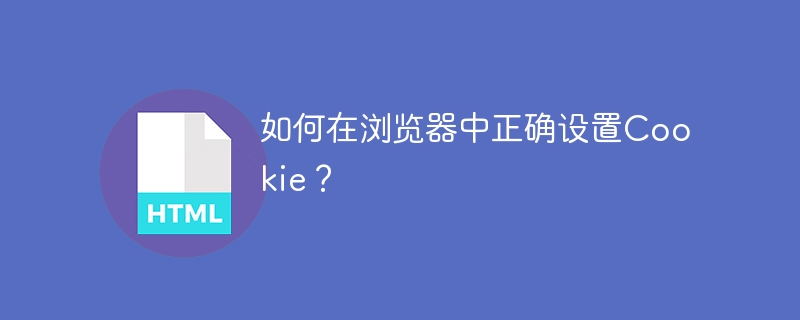Home >Web Front-end >HTML Tutorial >How to correctly set cookies in your browser?
How to correctly set cookies in your browser?
- WBOYWBOYWBOYWBOYWBOYWBOYWBOYWBOYWBOYWBOYWBOYWBOYWBOriginal
- 2024-01-19 10:10:072305browse

In the development of modern web applications, cookies are one of the most important concepts. A cookie is a piece of text sent by the server to the client browser that contains some information about the user and the application. This information can be saved on the user's computer and sent with future requests. This article will explain how to correctly set cookies in your browser.
Cookies are typically used to save user login information and other session data, and are commonly used when tracking website visitors. In JavaScript applications, we can use document.cookie to access and create cookies. Below are some code examples for setting cookies.
//Set a cookie named "name", specify its value as "value", and expire after 30 days
var date = new Date();
date.setTime(date.getTime( ) (30 24 60 60 1000));
var expires = "expires=" date.toUTCString();
document.cookie = "name" "= " "value" ";" expires ";path=/";
In this example, we create a Cookie named "name" and set its value to "value". In this cookie, we set an expiration time for it, which will expire in 30 days. In addition, we also specify a path "/" for the cookie so that the cookie can be used throughout the site.
The following is another example of setting a cookie, which stores a JSON object in the cookie.
//Set the cookie named "name" as a JSON object and specify an expiration time
var userInfo = {
name: "John",
age: 30,
email: "john.doe@example.com"
};
var cookieValue = encodeURIComponent(JSON.stringify(userInfo));
var expires = new Date();
expires .setMonth(expires.getMonth() 1);
document.cookie = "name=" cookieValue "; expires=" expires.toUTCString() "; path=/";
In this example , we create a cookie named "name" and set its value to a JavaScript object. First we encode the object, then stringify it and store it in a cookie value. Here we set an expiration time which will expire after 1 month.
We can also obtain the specified Cookie value by reading the document.cookie attribute.
//Get the Cookie value named "name"
function getCookie(name) {
var nameEQ = name "=";
var ca = document.cookie.split(' ;');
for(var i=0;i
var c = ca[i]; while (c.charAt(0) == ' ') c = c.substring(1,c.length); if (c.indexOf(nameEQ) == 0) return c.substring(nameEQ.length,c.length);
}
return null;
}
This example Is a simple JavaScript function used to get the value of a cookie with a specified name. In this function, we first do this by splitting the document.cookie into a series of cookie strings and then get the name and value of each cookie. Iterate through these cookies, find the cookie you are looking for, and return its value. If the specified cookie is not found, null is returned.
To summarize, Cookie is the most important concept in modern Web development, which can help us save user data and other session information. We can use JavaScript to read and set the value of Cookie, and control the expiration time and path of Cookie by setting some parameters. Through the above code examples, we can better understand how to correctly set cookies in the browser.
The above is the detailed content of How to correctly set cookies in your browser?. For more information, please follow other related articles on the PHP Chinese website!

